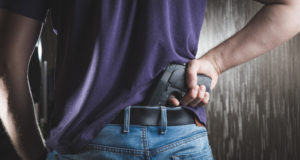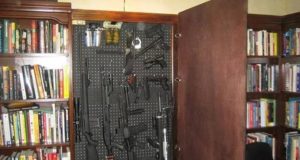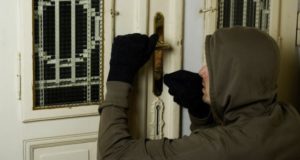USMC Lt. Col. John Dean “Jeff” Cooper (1920-2006), founder of Gunsite Academy, contributed much to the evolution of American handgun and rifle training, for both hunting and defense applications.
Cooper embraced the concept of defensive living and had the ability to distill theory into useful instruction. He is credited with pioneering a number of advances — the scout rifle concept and the .40 caliber cartridge being two of them. These were visionary concepts, but ones already taking their place in history. As we proceed through the millennium without him, it seems that it will be Cooper’s philosophical contributions, more than the physical ones, that will endure far beyond his lifetime.
One such contribution was his translation of levels of awareness into easy-to-remember color codes. These color codes, and their corresponding “conditions,” are guidance for a life of relatively easy preparedness for self-defense. The color codes are a guide to both thought and behavior, and are intended for use by individuals.
Those who traveled by air in the couple of years following the events of Sept, 11, 2001 may remember color codes being announced over airport PA systems. As the nascent Department of Homeland Security discovered, the color code system isn’t made for the masses. It’s for you to apply to your own circumstances.
You Don’t Need A Firearms License For This Weapon!
Let’s examine the Cooper Color Codes:
Condition White: Being in white is to be unaware and unprepared. Look around you during the day. Do you see people absorbed in their phones as they stand in line at the store? A coworker who is startled by the presence of someone standing by their desk? These are examples of Condition White. If you’re in White when someone decides to make you or your location the target of a crime, it’s less likely that your response will be conducive to survival.
Condition Yellow: This is a relaxed state of awareness. The five senses are alive to the environment around you, as is your sixth sense of something being not quite right. To be effective in avoiding, preventing or otherwise responding to a criminal attack, Condition Yellow is where you should live during all waking moments.
Condition Yellow is not a state of restlessness or paranoia. In fact, living in yellow makes life richer. Along with noticing potential threats, you’ll also notice the richness of the world around you.
Simply making an effort to be situationally aware — of the sights, smells and things going on around you — makes you safer. It buys you time to avoid trouble, and time to prepare a defense if necessary. This includes making a visual scan of what’s going on in every new environment you enter. Where are the emergency exits? Are people behaving in a manner that suits the setting?
In yellow, you can make a game out of noticing where people’s hands are, and picking out items that offer escape (like a door) or cover (like a big freezer) in case trouble happens. This keeps your mind from wandering to less useful distractions, and with practice, becomes a natural habit.
I’ve not been in military combat, but I’ve had the gift of learning from many combat veterans. The one piece of advice they share consistently, especially those who’ve served as civilian contractors in potentially unfriendly territory, is to stay aware. It doesn’t take any more energy than Condition White, and may just save your life.
Condition Orange: This is a focused state of awareness. A specific potential or probable threat has been identified. Maybe it’s the smell of natural gas; act accordingly! Maybe someone just entered a social function on a hot summer day, clad in a long coat.
Condition Orange can be sustained for as long as necessary, but can be fatiguing when sustained. During Orange, a plan of escape or engagement should be in process. If the threat is a human being, establish eye contact, and keep it, even if they’re not returning the favor. This is a deterrent to most garden variety criminals, and also allows you to note any moves on their part that may signal ill intent or an attack.
In Orange, it may be appropriate to stage your hand on your weapon, still in concealment. This, too, is a sign to the experienced street thug. If an apparent move to attack (rob, mug, abduct, etc.) continues, it is probably time to unsheathe the weapon, or, if it’s an improvised weapon like a kitchen tool or garden implement, wield it at the ready. The Tueller Drill, a commonly taught technique in law enforcement and increasingly in civilian tactics, demonstrates that it takes a mere 1.5 seconds for a determined person to cover a distance of 21 feet — the length of the average living room. Most people are unable to draw and fire or strike in less than two seconds.
Proper breathing is essential in Condition Orange. The simplest explanation of this is to inhale so that you can feel your belly expand your waistband. Breath control keeps your logical brain engaged, your fine motor skills intact, and your heart rate under control. You’ll need that if the situation escalates to Condition Red.
Condition Red: In Red, the fight is on. At this point, your plan of escape or counterattack is in full force. Fight, or run, as if your life depends on it. And mentally decide, right now, that if a situation goes to Red, you will prevail, regardless of what the opponent or situation does. As one of my mentors, CJ Caracci, says, “The will to win is more important than the skill to win.” But, as we all know, luck favors the prepared!
What advice would you add on situational awareness and using the Cooper Color Codes? Share your tips in the section below:
 Off The Grid News Better Ideas For Off The Grid Living
Off The Grid News Better Ideas For Off The Grid Living




